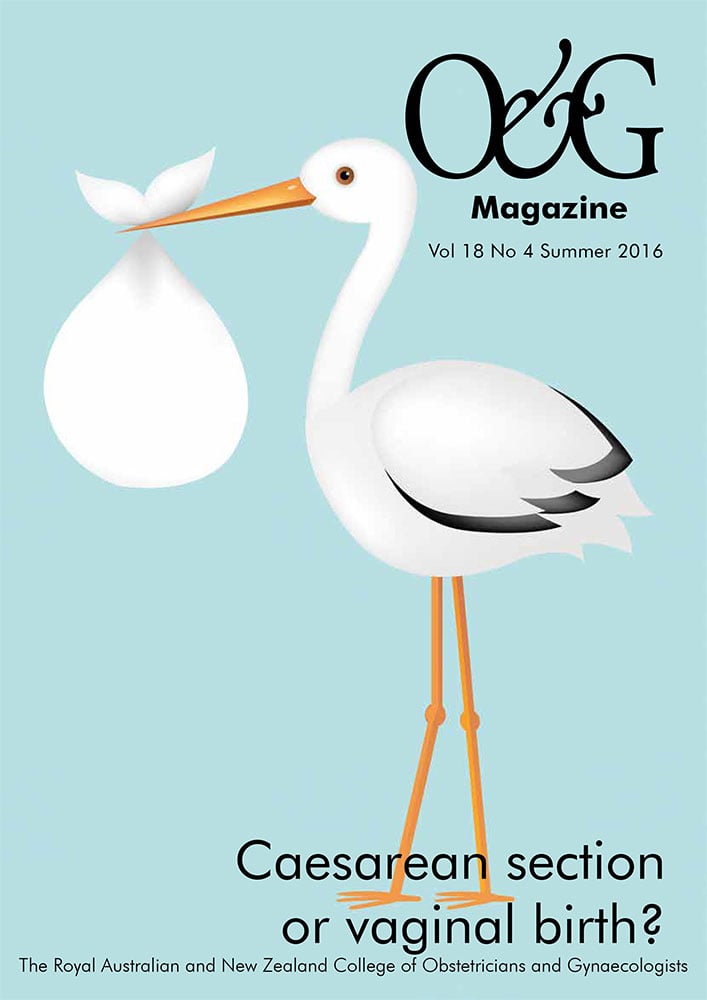What constitutes a good birth? For an obstetrician, the health of the mother and baby is paramount and, in many cases, we may be comfortable accepting a more interventional approach if it becomes necessary. For many women, however, the balance may be different, as giving birth child is an event overlaid with cultural and personal desires; one study reports that seven per cent of women perceived their birth experience as negative.1 There is no single preferred birth plan that will satisfy all women, and nothing can absolutely protect against a feeling of disappointment if things do not go as planned. An unexpected or traumatic birth experience can lead to long-term issues for women and it is important to recognise this potential and to offer assistance where possible.
Birth trauma
It is recognised that, in the postnatal period, one to two per cent of women experience symptoms satisfying the criteria of post-traumatic stress disorder (PTSD).2
As defined in the American Psychiatric Association Diagnostic and Statistical Manual of Mental Disorders, Fifth Edition (DSM-5),3 for a person to satisfy a diagnosis of PTSD, they must meet a number of criteria:
- That the person was exposed to actual or threatened death, serious injury or sexual violation. This may be either:
• Directly experiencing the traumatic event(s)
• Witnessing, in person, the event(s) as it occurred to others
• Learning that the traumatic event(s) occurred to a close family member or friend
• Experiencing repeated or extreme exposure to aversive details of the traumatic event; this does not apply to exposure through media such as television, movies, or pictures, but can include workers involved in caring for such events. - The persistent re-experiencing of the event including:
• Thoughts or perceptions
• Images
• Dreams
• Illusions or hallucinations
• Dissociative flashback episodes
• Intense psychological distress or reactivity to cues that symbolise some aspect of the event. - The avoidance of stimuli that are associated with the trauma and numbing of general responsiveness, as determined by the presence of one or both of the following:
• Avoidance of thoughts, feelings, or conversations associated with the event
• Avoidance of people, places, or activities that may trigger recollections of the event - Symptoms of negative alterations in cognitions and mood associated with the traumatic event(s):
• Inability to remember an important aspect of the event(s)
• Persistent and exaggerated negative beliefs about oneself, others, or the world
• Persistent, distorted cognitions about the cause or consequences of the event(s)
• Persistent negative emotional state
• Markedly diminished interest or participation in significant activities
• Feelings of detachment or estrangement from others
• Persistent inability to experience positive emotions - Marked alterations in arousal and reactivity including:
• Irritable behavior and angry outbursts
• Reckless or self-destructive behaviour
• Hypervigilance
• Exaggerated startle response
• Concentration problems
• Sleep disturbance.4 5
While for most women childbirth is not traumatic, for many women uncertainty, pain and a genuine fear for the wellbeing of themselves and their baby mean that childbirth has the potential to result in PTSD.
A 2012 review by Andersen et al listed a large number of criteria associated with a higher possibility of PTSD after childbirth. They classified them into top-, intermediate- and bottom-rated predictors.6 Top-rated factors were subjective distress in labour, including loss of control, obstetric emergencies, emergency caesarean section, instrumental delivery or pain. Intermediate predictors included infant complications, including preterm birth, maternal mental difficulties both before and during pregnancy, maternal prepartum or intrapartum medical complications,a previous history of trauma or sexual abuse, and a lack of support from staff or their partner. Factors that were not associated with a risk of postnatal PTSD symptoms included duration of labour, perineal tearing, parity and whether the pregnancy was planned.7 The authors hypothesised that a mechanism for the development of PTSD after childbirth included three factors:
- A predisposing psychological disposition in the individual
- A traumatising event in childbirth
- The perception of this event being traumatic.
They then conclude that perceived support was also of great importance and provides an opportunity for reducing the risk of PTSD. 8
It is important to note that these are only predictive factors. Unfortunately, the absence of these factors is not completely protective against the development of PTSD after childbirth, as some women without any risk factors experience psychological trauma after an uncomplicated vaginal birth.9
Reducing the psychological distress of childbirth
The idea that childbirth, particularly with an unexpected outcome, can have adverse psychological effects on women will not be surprising to clinicians looking after women during and after pregnancy. In addition to the women experiencing clinical PTSD, there are a greater number of women who will live with negative perceptions of their birth experience that may affect their future reproductive choices. There are a number of techniques that may be employed to reduce this possibility in women and their partners.
Antenatal care
Anderson et al identified loss of control, fear and pain as top-rated factors associated with the development of postnatal PTSD symptoms.10 To some extent, these can be related to the rapid introduction of new and unfamiliar interventions and possibilities during labour when women are already stressed and in pain. There is an opportunity antenatally to educate women about the possibilities of unexpected changes in their birth plans and to allow them to discuss their fears and perceptions of the range of obstetric possibilities. This can be done during antenatal classes or in individual sessions with obstetricians or midwives.
In addition to basic education, the antenatal period provides a time for women, their partners and their carers, to discuss their personal beliefs and expectations regarding their birth and to find some common ground. In most cases women and their carers will hold similar desires for their labour care, but in some cases these expectations will be very different. It will be less traumatic if these differences can be explored prior to labour and a mutually acceptable plan can be made between the woman and her caregivers. If the differences between their plans are too great, then both the patient and carer have time to make alternative arrangements before birth.
Intrapartum care
While obstetric emergencies, emergency caesarean and instrumental deliveries cannot always be avoided, there are intrapartum factors that could be used to reduce the traumatic effect of an unexpected outcome. The feelings of loss of control and perceived lack of support during labour are highly associated with psychological distress. Unfortunately, both of these feelings can easily be exacerbated in an emergency situation where staff concentrate on technical roles to expedite delivery or provide emergency care, and where the birth partner may also be unable to provide meaningful support due to their own distress.
In many situations, it may be that there is some time in which an event such as emergency caesarean or instrumental delivery declares itself as a possibility and it is desirable that the woman and her partner are aware of this possibility and included in the decision, rather than keeping information from them until a sudden change of birth plan is made. An atmosphere of rush and panic will only increase everyone’s levels of anxiety and reduce performance. In any emergency situation it is important that someone is calm, at birth it is helpful if that person is the obstetrician.
Postpartum care
Following a traumatic or unexpected birth outcome, we have the opportunity to reduce, identify and treat women experiencing adverse psychological events. As stated above, a feeling of support will help to reduce the development of PTSD symptoms. Women should be offered the opportunity to openly discuss their birth and the feelings arising from it both soon after the birth and later if desired. Their obstetrician, midwife, GP or other professional is well placed to offer this support. How this open discussion is best achieved is unclear. A 2015 Cochrane review on the effectiveness of formal psychological debriefing methods on the development of PTSD symptoms following traumatic childbirth found no systematic differences between standard postnatal care and formal debriefing at up to 12 months postpartum.11
The identification and treatment of women who develop PTSD following childbirth is beyond the scope of this article. In many cases the symptoms of PTSD listed above can be appreciated by people providing postpartum care with an appropriate level of clinical awareness of the patient’s individual situation. If PTSD is diagnosed, treatment will depend on local factors. In general, however, referral to a psychiatrist or psychologist with an interest in perinatal mental health or trauma is likely to be appropriate.
References
- Waldenström U, Hildingsson I, et al. A Negative Birth Experience: Prevalence and Risk Factors in a National Sample. Birth. 2004;31:17-27.
- Andersen LB, Melvaer LB, et al. Risk factors for developing post-traumatic stress disorder following childbirth: a systematic review. Acta Obstet et Gynecol Scandinavica. 2012;91:1261–1272.
- American Psychiatric Association: Diagnostic and Statistical Manual of Mental Disorders, Fifth Edition. 2013. Arlington, VA.
- American Psychiatric Association: Diagnostic and Statistical Manual of Mental Disorders, Fifth Edition. 2013. Arlington, VA.
- Gore TA. 2016. Posttraumatic Stress Disorder Clinical Presentation.[cited 2016 8 October] Available from: http://emedicine. medscape.com/article/288154-clinical.
- Andersen LB, Melvaer LB, et al. Risk factors for developing post-traumatic stress disorder following childbirth: a systematic review. Acta Obstet et Gynecol Scandinavica. 2012;91:1261–1272.
- Andersen LB, Melvaer LB, et al. Risk factors for developing post-traumatic stress disorder following childbirth: a systematic review. Acta Obstet et Gynecol Scandinavica. 2012;91:1261–1272.
- Andersen LB, Melvaer LB, et al. Risk factors for developing post-traumatic stress disorder following childbirth: a systematic review. Acta Obstet et Gynecol Scandinavica. 2012;91:1261–1272.
- Bastos MH, Furuta M, et al. Debriefing interventions for the prevention of psychological trauma in women following childbirth. Cochrane Database of Systematic Reviews. Issue 4. Art. No.: CD007194. DOI: 10.1002/14651858. CD007194.pub2.
- Andersen LB, Melvaer LB, et al. Risk factors for developing post-traumatic stress disorder following childbirth: a systematic review. Acta Obstet et Gynecol Scandinavica. 2012;91:1261–1272.
- Bastos MH, Furuta M, et al. Debriefing interventions for the prevention of psychological trauma in women following childbirth. Cochrane Database of Systematic Reviews. Issue 4. Art. No.: CD007194. DOI: 10.1002/14651858. CD007194.pub2.






Leave a Reply